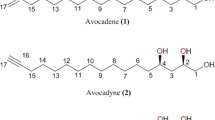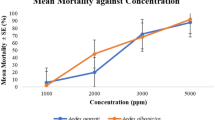Abstract
Aedes aegypti L. is the major vector of the arboviruses responsible for dengue fever, one of the most devastating human diseases. Papyracillic acid, the main phytotoxin produced by Ascochyta agropyrina var. nana, was evaluated in a preliminary screening together with other fungal phytotoxins, cyclopaldic acid, seiridin and sphaeropsidin A for their biting deterrent and larvicidal activities against Ae. aegypti. Because papyracillic acid previously showed a strong mosquito biting deterrent activity, five already known and six new derivatives were prepared in the current study to carry out a structure–activity relationship. All the compounds showed biting deterrence higher than the solvent control, ethanol. Biting deterrent activity of compounds 8, 9, 10 and 12 with biting deterrent index values of 0.76, 0.86, 0.72 and 0.74 nmol/cm2 was similar to DEET, which was 25 nmol/cm2. None of these compounds showed any larvicidal activity at the highest testing dose of 100 ppm. The bioassay results indicated that the structural feature responsible for the activity of compound 1 was probably the furanone ring. The presence of the alternative substituted cyclobutene, oxiran or substituted 4H-1,2,3-oxadiazine rings in some derivatives may be responsible for an increase in activity.




Similar content being viewed by others

References
Abd Kadir SL, Yaakob H, Mohamed Zulkifli R (2013) Potential anti-dengue medicinal plants: a review. J Nat Med 67:677–689
Ali A, Cantrell CL, Bernier UR, Duke SO, Schneider JC, Khan IA (2012) Aedes aegypti (Diptera: Culicidae) biting deterrence: structure–activity relationship of saturated and unsaturated fatty acids. J Med Entomol 49:1370–1378
Ali A, Demirci B, Kiyan HT, Bernier UR, Tsikolia M, Wedge DE, Khan IA, Baser KHC, Tabanca N (2013) Biting deterrence, repellency and larvicidal activity of Ruta chalepensis (Sapindales: Rutaceae) essential oil and its major individual constituents against mosquitoes. J Med Entomol 50:1267–1274
Andolfi A, Maddau L, Basso S, Linaldeddu B, Cimmino A, Scanu B, Deidda A, Tuzi A, Evidente A (2014) Diplopimarane, a 20-nor-ent-pimarane produced by the oak pathogen Diplodia quercivora. J Nat Prod 77:2352–2360
Berger S, Braun S (2004) 200 and more basic NMR experiments: a practical course, 1st edn. Wiley-VCH, Weinheim
Bissinger BW, Roe RM (2010) Tick repellents: past, present, and future. Pestic Biochem Physiol 96:63–79
Bissinger DR, Apperson CS, Sonenshine DE, Watson DW, Roe RM (2009) Efficacy of the new repellent BioUD against three species of ixodid ticks. Exp Appl Acarol 48:239–250
Breitmaier E, Voelter V (1987) Carbon-13 NMR Spectroscopy. VCH, Weinheim
Carey FA, Sundberg RJ (1977) Advanced organic chemistry. Plenum Press, New York
Carter SW (1989) A review of the use of synthetic pyrethroids in public health and vector pest control. J Pest Sci 27:361–374
Cimmino A, Andolfi A, Avolio F, Ali A, Tabanca N, Khan IA, Evidente A (2013a) Cyclopaldic acid, seiridin, and sphaeropsidin A as fungal phytotoxins, and larvicidal and biting deterrents against Aedes aegypti (Diptera: Culicidae): structure–activity relationships. Chem Biodivers 10:1239–1251
Cimmino A, Andolfi A, Zonno MC, Avolio F, Santini A, Tuzi A, Berestetskyi A, Vurro M, Evidente A (2013b) Chenopodolin: a phytotoxic unrearranged ent-pimaradiene diterpene produced by Phoma chenopodicola, a fungal pathogen for Chenopodium album biocontrol. J Nat Prod 76:1291–1297
Cole RJ, Jarvis BB, Schweikert MA (2003) Handbook of secondary fungal metabolites. Academic Press, Amsterdam
Dayan FE, Cantrell CL, Duke SO (2009) Natural products in crop protection. Bioorgan Med Chem 14:4022–4034
Demirci B, Tsikolia M, Bernier UR, Agramonte NM, Alqasoumi SI, Al-Yahya MA, Al-Rehaily AJ, Yusufoglu HS, Demirci F, Baser KHC, Khan IA, Tabanca N (2013) A new natural source: Phoenix dactylifera L. spathe essential oil—chemical composition and repellent activity against the yellow fever mosquito, Aedes aegypti. Acta Trop 128:557–560
Duke SO, Cantrell CL, Meepagala KM, Wedge DE, Tabanca N, Schrader KK (2010) Natural toxins for use in pest management. Toxins 2:1943–1962
Duke SO, Baerson SR, Cantrell CL, Wedge DE, Meepagala KM, Pan Z, Rimando AM, Schrader KK, Tabanca N, Owens DK, Dayan FE (2014) Phytochemicals for pest management: current advances and future opportunities. Rec Adv Phytochem 43:71–94
Evidente A (2010) New fungal metabolites, as antifungal, herbicides and insecticides for biocontrol of agrarian pests. In: Gupta VJ (ed) Comprehensive bioactive natural products. Studium Press LLC, Houston, p 333
Evidente A, Randazzo G, Ballio A (1986) Toxins produced by three species of Seiridium affecting cypress trees. J Nat Prod 49:593–603
Evidente A, Sparapano L, Motta A, Giordano F, Fierro O, Frisullo S (1996) A phytotoxic pimarane diterpene of Sphaeropsis sapinea f. sp. cupressi, the pathogen of a canker disease of cypress. Phytochemistry 42:1541–1546
Evidente A, Berestetskiy A, Cimmino A, Tuzi A, Superchi S, Melck D, Andolfi A (2009) Papyracillic acid, a phytotoxic 1,6-dioxaspiro [4,4] nonene produced by Ascochyta agropyrina var. nana, a potential mycoherbicide for Elytrigia repens biocontrol. J Agric Food Chem 57:11168–11173
Evidente A, Andolfi A, Cimmino A, Abouzeid AM (2010) Phytotoxins produced by fungi responsible of forestal plant diseases. In: Salazar A, Rios I (eds) Sustainable agriculture: technology, planning and management. Nova Science Publishers Inc., New York, p 177
Evidente A, Maddau L, Scanu B, Andolfi A, Masi M, Motta A, Tuzi A (2011) Sphaeropsidones, phytotoxic dimedone methyl ethers produced by Diplodia cupressi: a structure–activity relationship study. J Nat Prod 74:757–763
Farias DF, Cavalheiro MG, Viana SM, De Lima GP, Da Rocha-Bezerra LC, Ricardo NM, Carvalho AF (2009) Insecticidal action of sodium anacardate from Brazilian cashew nut shell liquid against Aedes aegypti. J Am Mosq Control Assoc 25:386–389
Graniti A, Sparapano L, Evidente A (1992) Cyclopaldic acid, a major phytotoxic metabolite of Seiridium cupressi, the pathogen of a canker disease of cypress. Plant Pathol 41:563–568
Hoel D, Pridgeon JW, Bernier UR, Chauhan K, Meepagala K, Cantrell CL (2010) Departments of Defense and Agriculture team up to develop new insecticides for mosquito control. Wingbeats 21:19–34
Kishore N, Mishra BB, Tiwari VK, Tripathi V, Lall N (2014) Natural products as leads to potential mosquitocides. Phytochem Rev 13:587–627
Klun JA, Kramer M, Debboun M (2005) A new in vitro bioassay system for discovery of novel human-use mosquito repellents. J Am Mosq Control Assoc 21:64–70
Lallemand B, Masi M, Maddau L, De Lorenzi M, Dam R, Cimmino A, Moreno Y, Banuls AL, Andolfi A, Kiss R, Mathieu V, Evidente A (2012) Evaluation of in vitro anticancer activity of sphaeropsidins A-C, fungal rearranged pimarane diterpenes, and semisynthetic derivatives. Phytochem Lett 5:770–775
Le Calvé B, Lallemand B, Perrone C, Lenglet G, Depauw S, Van Goietsenoven G, Bury M, Vurro M, Herphelin F, Andolfi A, Zonno MC, Mathieu V, Dufrasne F, Van Antwerpen P, Poumay Y, David-Cordonnier MH, Evidente A, Kiss R (2011) In vitro anticancer activity, toxicity and structure–activity relationships of phyllostictine A, a natural oxazatricycloalkenone produced by the fungus Phyllosticta cirsii. Toxicol Appl Pharmacol 254:8–17
Liu JJ, Ding YH, Feng JK, Tao YG, Sun CC (2002) Theoretical study on mechanism of the 3CH2 + N2O reaction. J Phys Chem A 106:1746–1764
Mulder JJC (1998) Teoretical organic chemistry. Elsevier, The Netherland
Pretsch E, Bühlmann P, Affolter C (2000) Structure determination of organic compounds—tables of spectral data, 3rd edn. Springer-Verlag, Berlin, p 161
Pridgeon JW, Meepagala K, Becnel JJ, Clark GG, Pereira RM, Linthicum KJ (2007) Structure–activity relationships of 33 piperidines as toxicants against female adults of Aedes aegypti (Diptera: Culicidae). J Med Entomol 44:263–269
Reiter P (2010) Yellow fever and dengue: a threat to Europe? Euro Surveill 15:19509
SAS Institute (2007) SAS OnlineDoc, version 9.2. SAS Institute, Cary, NC
Schreck CE, Mount GA, Carlson DA (1982) Wear and wash persistence of permethrin used as a clothing treatment for personal protection against the lone star tick (Acari: Ixodidae). J Med Entomol 19:143–146
Shan R, Heidren A, Stadler M, Sterner O (1996) Papyracillic acid, a new penicillic acid analogue from the ascomycete Lachnum papyraceum. Tetrahedron 52:10249–10254
Sparapano L, Evidente A, Ballio A, Graniti A, Randazzo G (1986) New phytotoxic butenolides produced by Seiridium cardinale, the pathogen of cypress canker disease. Experientia 42:627–628
Tabanca N, Wedge DE, Abbas A, Khan IA, Kaplancikli ZA, Altintop MD (2012) Antifungal, mosquito deterrent and larvicidal activity of N-(benzylidene)-3-cyclohexylpropionic acid hydrazide derivatives. Med Chem Res 22:2602–2609
Tabanca N, Bernier UR, Ali A, Wang M, Demirci B, Blythe EK, Khan SI, Baser KHC, Khan IA (2013) Bioassay-guided investigation of two Monarda essential oils as repellent of yellow fever mosquito against Aedes aegypti. J Agric Food Chem 61:8573–8580
Whitehorn J, Farrar J (2010) Dengue. Br Med Bull 95:161–173
WHO (2009) Dengue guidelines for diagnosis, treatment, prevention and control. World Health Organization, Ginevra, pp 1–144
Acknowledgments
The manuscript was supported in part by a Grant from the Italian Ministry of University and Research (MIUR), in part by USDA/ARS Grant No. 56-6402-1-612 and Deployed War-Fighter Protection Research Program Grant funded by the US Department of Defense through the Armed Forces Pest Management Board. The authors thank the Istituto di Chimica Biomolecolare del CNR, Pozzuoli, Italy, for recording NMR spectra. We thank Dr. James J. Becnel, Mosquito and Fly Research Unit, Center for Medical, Agricultural and Veterinary Entomology, USDA-ARS, Gainesville, Florida, USA, for supplying Ae. aegypti eggs. The authors wish to thank Dr. Jon F. Parcher, National Center for Natural Products Research, The University of Mississippi, University, MS 38677 USA, for English grammar corrections and suggestions.
Author information
Authors and Affiliations
Corresponding authors
Rights and permissions
About this article
Cite this article
Cimmino, A., Evidente, M., Masi, M. et al. Papyracillic acid and its derivatives as biting deterrents against Aedes aegypti (Diptera: Culicidae): structure–activity relationships. Med Chem Res 24, 3981–3989 (2015). https://doi.org/10.1007/s00044-015-1439-0
Received:
Accepted:
Published:
Issue Date:
DOI: https://doi.org/10.1007/s00044-015-1439-0



